 In a recent post, Global Warning, we looked at concerns about the global economy. One of these was about the ineffectiveness of monetary policy to stimulate aggregate demand and to restore growth rates. Despite the use of unconventional monetary policies, such as quantitative easing and negative interest rates, and despite the fact that these policies have become the new convention, they have failed to do enough to bring sustained recovery.
In a recent post, Global Warning, we looked at concerns about the global economy. One of these was about the ineffectiveness of monetary policy to stimulate aggregate demand and to restore growth rates. Despite the use of unconventional monetary policies, such as quantitative easing and negative interest rates, and despite the fact that these policies have become the new convention, they have failed to do enough to bring sustained recovery.
The two articles below argue that the failure has been due to a flawed model of monetary policy: one that takes too little account of the behaviour of banks and the drivers of consumption and of physical investment. Negative interest rates on banks’ holdings of reserves in central banks are hardly likely to push down lending rates to businesses sufficiently to stimulate investment in new plant and machinery if firms already have overcapacity. And consumers are unlikely to borrow more for consumption if their wages are barely rising and they already have debts that they fear will be difficulty to pay off.
As Joseph Stiglitz points out:
As real interest rates have fallen, business investment has stagnated. According to the OECD, the percentage of GDP invested in a category that is mostly plant and equipment has fallen in both Europe and the US in recent years. (In the US, it fell from 8.4% in 2000 to 6.8% in 2014; in the EU, it fell from 7.5% to 5.7% over the same period.) Other data provide a similar picture.
And the unwillingness of many firms and individuals to borrow is matched by banks’ caution about lending in an uncertain economic environment. Many are more concerned about building their capital and liquidity ratios to protect themselves. In these circumstances, negative interest rates have little effect on stimulating bank lending and, by hurting their balance sheets through lower earnings on the money markets, may even encourage them to lend less
In these circumstances, negative interest rates have little effect on stimulating bank lending and, by hurting their balance sheets through lower earnings on the money markets, may even encourage them to lend less
What central banks should be doing, argue both Stiglitz and Elliott, is finding ways of directly stimulating consumption and investment. Perhaps this will involve central banks “focusing on the flow of credit, which means restoring and maintaining local banks’ ability and willingness to lend to SMEs.” Perhaps it will mean using helicopter money, as we examined in the previous blog. As Larry Elliott points out:
The fact that economists at Deutsche Bank published a helpful cut-out-and-keep guide to helicopter  money last week is a straw in the wind.
money last week is a straw in the wind.
As the Deutsche research makes clear, the most basic variant of helicopter money involves a central bank creating money so that it can be handed to the finance ministry to spend on tax cuts or higher public spending. There are two differences with QE. The cash goes directly to firms and individuals rather than being channelled through banks, and there is no intention of the central bank ever getting it back.
So if the model of monetary policy is indeed flawed, prepare for more unconventional measures
Articles
What’s Wrong With Negative Rates?, Project Syndicate, Joseph Stiglitz (13/4/16)
The bad smell hovering over the global economy The Guardian, Larry Elliott (17/4/16)
Questions
- What arguments does Stiglitz use to support his claim that the model of monetary policy currently being used is flawed?
- In what ways has monetary policy hurt older people and what has been the effect on their spending and on aggregate demand in general?
- Why has monetary policy encouraged investors to shift their portfolios toward riskier assets?
- Examine the argument that ultra-low interest rates may result in a rise in unemployment in the long term by affecting the relative prices of capital and labour.
- What forms might helicopter money take?
- Would the use of helicopter money necessarily result in an increase in aggregate demand? What would determine the size of any such increase?
 Project Syndicate is an organisation which produces articles on a range of economic, political and social topics written by eminent scholars, political and business leaders, policymakers and civic activists. It then makes these available to news media in more than 150 countries. Here we look at four such articles which assess the outlook for the European and global economies and even that of capitalism itself.
Project Syndicate is an organisation which produces articles on a range of economic, political and social topics written by eminent scholars, political and business leaders, policymakers and civic activists. It then makes these available to news media in more than 150 countries. Here we look at four such articles which assess the outlook for the European and global economies and even that of capitalism itself.
The general tone is one of pessimism. Despite unconventional monetary policies, such as quantitative easing (QE) and negative nominal interest rates, the global recovery is anaemic. As the Nouriel Roubini articles states:
Unconventional monetary policies – entrenched now for almost a decade – have themselves become conventional. And, in view of persistent lacklustre growth and deflation risk in most advanced economies, monetary policymakers will have to continue their lonely fight with a new set of ‘unconventional unconventional’ monetary policies.
Perhaps this will involve supplying additional money directly to consumers and/or business in a so-called ‘helicopter drop’ of money. Perhaps it will be supplying money directly to governments to finance infrastructure projects – a policy dubbed ‘people’s quantitative easing‘. Perhaps it will involve taxing the holding of cash by banks to encourage them to lend.
 The Hans-Werner Sinn article looks at some of the consequences of the huge amount of money created through QE and continuing to be created in the eurozone. Although it has not boosted consumption and investment nearly as much as desired, it has caused bubbles in various asset markets. For example, the property market has soared in many countries:
The Hans-Werner Sinn article looks at some of the consequences of the huge amount of money created through QE and continuing to be created in the eurozone. Although it has not boosted consumption and investment nearly as much as desired, it has caused bubbles in various asset markets. For example, the property market has soared in many countries:
Property markets in Austria, Germany, and Luxembourg have practically exploded throughout the crisis, as a result of banks chasing borrowers with offers of loans at near-zero interest rates, regardless of their creditworthiness.
The German property boom could be reined in with an appropriate jump in interest rates. But, given the ECB’s apparent determination to head in the opposite direction, the bubble will only grow. If it bursts, the effects could be dire for the euro.
The Jean Pisani-Ferry article widens the analysis of the eurozone’s problems. Like Roubini, he considers the possibility of a helicopter drop of money, which “would be functionally equivalent to a direct government transfer to households, financed by central banks’ permanent issuance of money”.
 Without such drastic measures he sees consumer and business pessimism (see chart) undermining recovery and making the eurozone vulnerable to global shocks, such as further weakening in China. (Click here for a PowerPoint of the chart.)
Without such drastic measures he sees consumer and business pessimism (see chart) undermining recovery and making the eurozone vulnerable to global shocks, such as further weakening in China. (Click here for a PowerPoint of the chart.)
Finally, Anatole Kaletsky takes a broad historical view. He starts by saying that “All over the world today, there is a sense of the end of an era, a deep foreboding about the disintegration of previously stable societies.” He argues that the era of ‘leaving things to the market’ is coming to an end. This was an era inspired by the monetarist and supply-side revolutions of the 1960s and 1970s that led to the privatisation and deregulation policies of Reagan, Thatcher and other world leaders.
But if the market cannot cope with the complexities of today’s world, neither can governments.
If the world is too complex and unpredictable for either markets or governments to achieve social objectives, then new systems of checks and balances must be designed so that political decision-making can constrain economic incentives and vice versa. If the world is characterized by ambiguity and unpredictability, then the economic theories of the pre-crisis period – rational expectations, efficient markets, and the neutrality of money – must be revised.
… It is obvious that new technology and the integration of billions of additional workers into global markets have created opportunities that should mean greater prosperity in the decades ahead than before the crisis. Yet ‘responsible’ politicians everywhere warn citizens about a ‘new normal’ of stagnant growth. No wonder voters are up in arms.
His solution has much in common with that of Roubini and Pisani-Ferry. “Money could be printed and distributed directly to citizens. Minimum wages could be raised to reduce inequality. Governments could invest much more in infrastructure and innovation at zero cost. Bank regulation could encourage lending, instead of restricting it.”
So will there be a new era of even more unconventional monetary policy and greater regulation that encourages rather than restricts investment? Read the articles and try answering the questions.
Articles
Unconventional Monetary Policy on Stilts Project Syndicate, Nouriel Roubini (1/4/16)
Europe’s Emerging Bubbles Project Syndicate, Hans-Werner Sinn (28/3/16)
Preparing for Europe’s Next Recession Project Syndicate, Jean Pisani-Ferry (31/3/16)
When Things Fall Apart Project Syndicate, Anatole Kaletsky (31/3/16)
Questions
- Explain how a ‘helicopter drop’ of money would work in practice.
- Why has growth in the eurozone been so anaemic since the recession of 2009/10?
- What is the relationship between tightening the regulations about capital and liquidity requirements of banks and bank lending?
- Explain the policies of the different eras identified by Anatole Kaletsky.
- Would it be fair to describe the proposals for more unconventional monetary policies as ‘Keynesian’?
- If quantitative easing was used to finance government infrastructure investment, what would be the effect on the public-sector deficit and debt?
- If the inflation of asset prices is a bubble, what could cause the bubble to burst and what would be the effect on the wider economy?
 Seven years ago (on 5 March 2009), the Bank of England reduced interest rates to a record low of 0.5%. This was in response to a deepening recession. It mirrored action taken by other central banks across the world as they all sought to stimulate their economies, which were reeling from the financial crisis.
Seven years ago (on 5 March 2009), the Bank of England reduced interest rates to a record low of 0.5%. This was in response to a deepening recession. It mirrored action taken by other central banks across the world as they all sought to stimulate their economies, which were reeling from the financial crisis.
Record low interest rates, combined with expansionary fiscal policy, were hoped to be enough to restore rates of growth to levels experienced before the crisis. But they weren’t. One by one countries increased narrow money through bouts of quantitative easing.
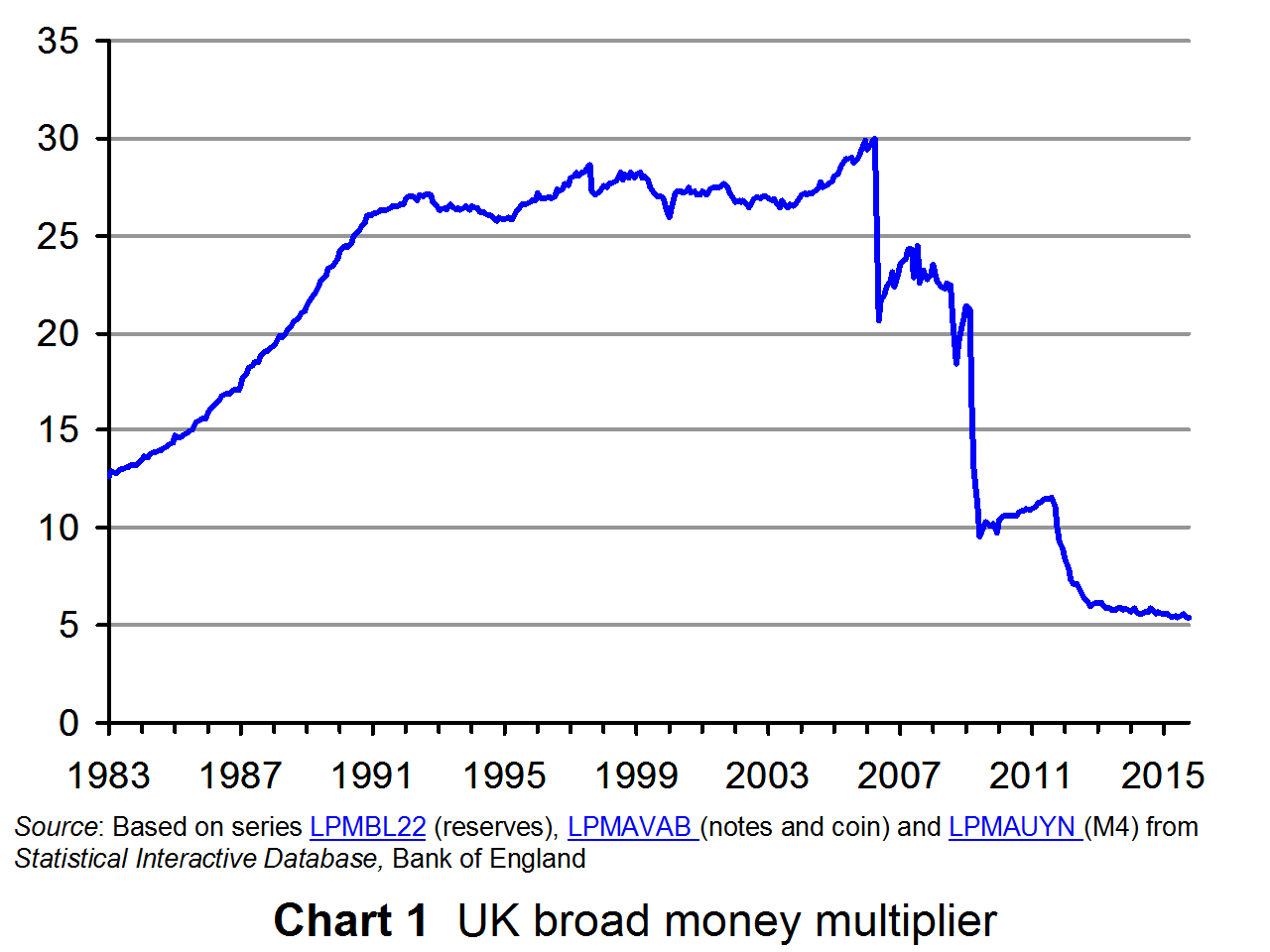 But as worries grew about higher government deficits, brought about by the expansionary fiscal policies and by falling tax receipts as incomes and spending fell, so fiscal policy became progressively tighter. Thus more and more emphasis was put on monetary policy as the means of stimulating aggregate demand and boosting economic growth.
But as worries grew about higher government deficits, brought about by the expansionary fiscal policies and by falling tax receipts as incomes and spending fell, so fiscal policy became progressively tighter. Thus more and more emphasis was put on monetary policy as the means of stimulating aggregate demand and boosting economic growth.
Ultra low interest rates and QE were no longer a short-term measure. They persisted as growth rates remained sluggish. The problem was that the higher narrow money supply was not leading to the hoped-for credit creation and growth in consumption and investment. 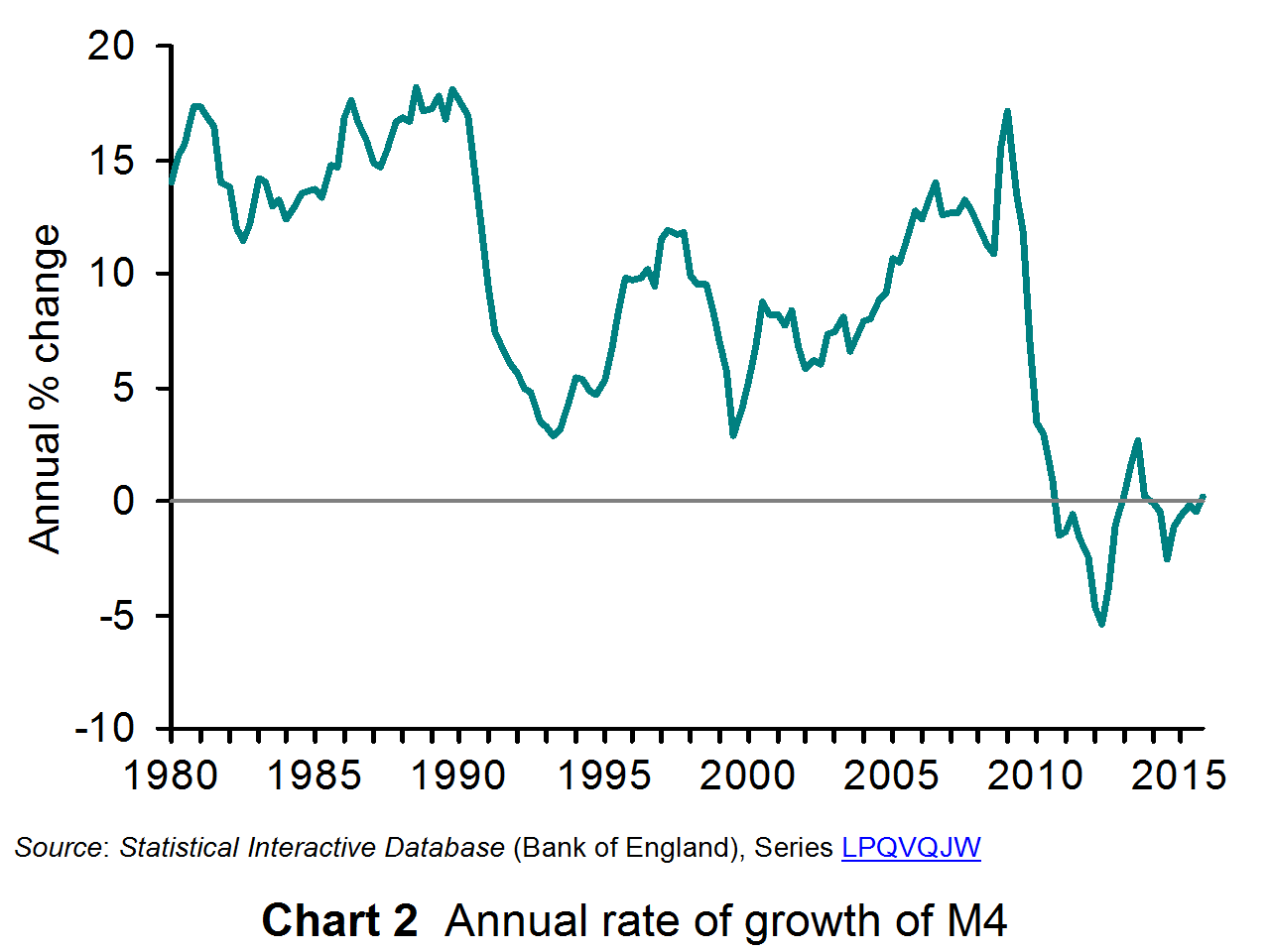 The extra money was being used for buying assets, such as shares and houses, not being spent on goods, services, plant and equipment. The money multiplier fell dramatically in many countries (see chart 1 for the case of the UK: click here for a PowerPoint) and there was virtually no growth in credit creation. Broad money in the UK (M4) has actually fallen since 2008 (see chart 2: click here for a PowerPoint), as it has in various other countries.
The extra money was being used for buying assets, such as shares and houses, not being spent on goods, services, plant and equipment. The money multiplier fell dramatically in many countries (see chart 1 for the case of the UK: click here for a PowerPoint) and there was virtually no growth in credit creation. Broad money in the UK (M4) has actually fallen since 2008 (see chart 2: click here for a PowerPoint), as it has in various other countries.
Additional monetary measures were put in place, including various schemes to provide money to banks for direct lending to companies or individuals. Central banks increasingly resorted to zero or negative interest rates paid to banks for deposits: see the blog posts Down down deeper and down, or a new Status Quo? and When a piggy bank pays a better rate. But still bank lending has stubbornly failed to take off.
Some indication that the ’emergency’ was coming to an end occurred in December 2015 when the US Federal Reserve raised interest rates by 0.25 percentage points. However, many commentators felt that that was too soon, especially in the light of slowing Chinese economic growth. Indeed, the Chinese authorities themselves have been engaging in a large scale QE programme and other measures to arrest this fall in growth.
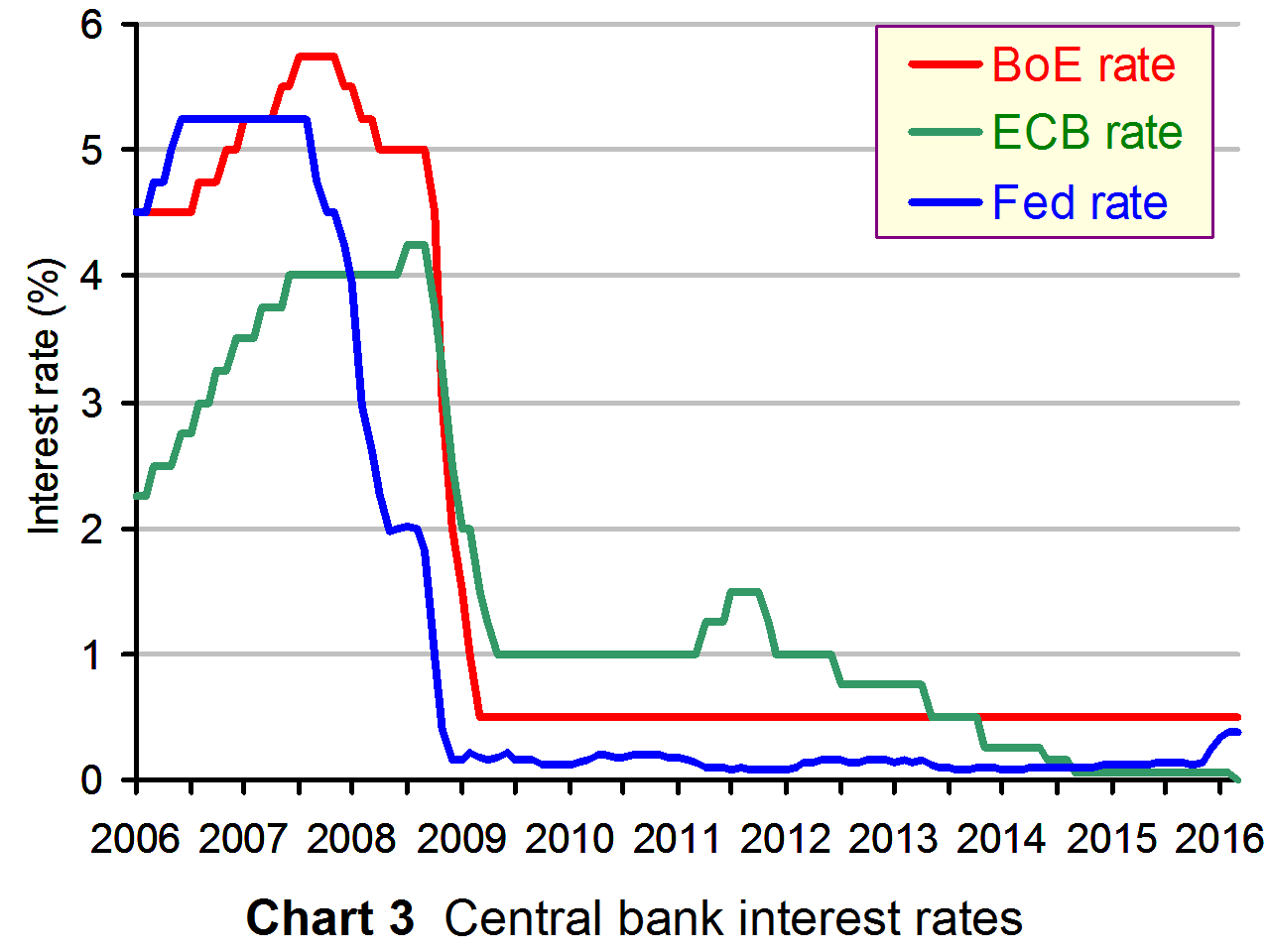 Although it cut interest rates in 2009 (to 1% by May 2009), the ECB was more cautious than other central banks in the first few years after 2008 and even raised interest rates in 2011 (to 1.5% by July of that year). However, more recently it has been more aggressive in its monetary policy. It has progressively cut interest rates (see chart 3: click here for a PowerPoint) and announced in January 2015 that it was introducing a programme of QE, involving €60 billion of asset purchases for at least 18 months from March 2015. In December 2015, it announced that it would extend this programme for another six months.
Although it cut interest rates in 2009 (to 1% by May 2009), the ECB was more cautious than other central banks in the first few years after 2008 and even raised interest rates in 2011 (to 1.5% by July of that year). However, more recently it has been more aggressive in its monetary policy. It has progressively cut interest rates (see chart 3: click here for a PowerPoint) and announced in January 2015 that it was introducing a programme of QE, involving €60 billion of asset purchases for at least 18 months from March 2015. In December 2015, it announced that it would extend this programme for another six months.
The latest move by the ECB was on March 10, when it took three further sets of measures to boost the flagging eurozone economy. It cut interest rates, including cutting the deposit rate paid to banks from –0.3% to –0.4% and the main refinancing rate from –0.05% to –0%; it increased its monthly quantitative easing from €60 billion to €80 billion; and it announced unlimited four-year loans to banks at near-zero interest rates.
It would seem that the emergency continues!
Articles
QE, inflation and the BoE’s unreliable boyfriend: seven years of record low rates The Guardian, Katie Allen (5/3/16)
The End of Alchemy: Money, Banking and the Future of the Global Economy by Mervyn King – review The Observer, John Kampfner (14/3/16)
How ‘negative interest rates’ marked the end of central bank dominance The Telegraph, Peter Spence (21/2/16)
ECB stimulus surprise sends stock markets sliding BBC News (10/3/16)
5 Takeaways From the ECB Meeting The Wall Street Journal, Paul Hannon (10/3/16)
ECB cuts interest rates to zero amid fears of fresh economic crash The Guardian, Katie Allen and Jill Treanor (10/3/16)
 Economists mixed on ECB stimulus CNBC, Elizabeth Schulze (10/3/16)
Economists mixed on ECB stimulus CNBC, Elizabeth Schulze (10/3/16)
ECB’s Draghi plays his last card to stave off deflation The Telegraph, Ambrose Evans-Pritchard (10/3/16)
ECB cuts rates to new low and expands QE Financial Times, Claire Jones (10/3/16)
Is QE a saviour, necessary evil or the road to perdition? The Telegraph, Roger Bootle (20/3/16)
ECB materials
Monetary policy decisions ECB Press Release (10/3/16)
Introductory statement to the press conference (with Q&A) ECB Press Conference, Mario Draghi and Vítor Constâncio (10/3/16)
 ECB Press Conference webcast ECB, Mario Draghi
ECB Press Conference webcast ECB, Mario Draghi
Questions
- What are meant by narrow and broad money?
- What is the relationship between narrow and broad money? What determines the amount that broad money will increase when narrow money increases?
- Explain what is meant by (a) the credit multiplier and (b) the money multiplier.
- Explain how the process of quantitative easing is supposed to result in an increase in aggregate demand. How reliable is this mechanism?
- Find out and explain what happened to the euro/dollar exchange rate when Mario Draghi made the announcement of the ECB’s monetary measures on 10 March.
- Is there a conflict for central banks between trying to strengthen banks’ liquidity and reserves and trying to stimulate bank lending? Explain.
- Why are “the ECB’s policies likely to destroy half of Germany’s 1500 savings and co-operative banks over the next five years”? (See the Telegraph article.
- What are the disadvantages of quantitative easing?
- What are the arguments for and against backing up monetary policy with expansionary fiscal policy? Consider different forms that this fiscal policy might take.
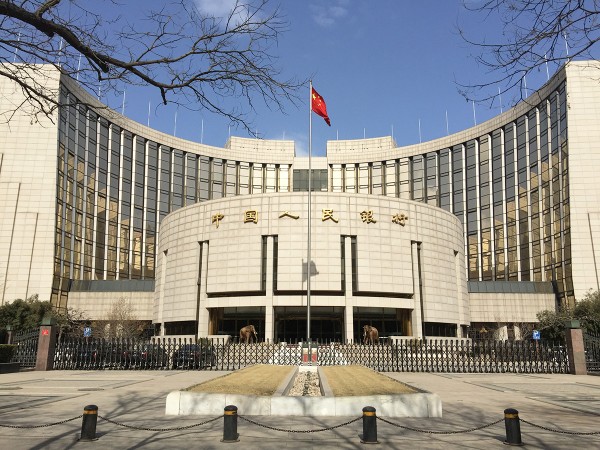 In recent months the Chinese central bank (the People’s Bank of China) has taken a number of measures to boost aggregate demand and arrest the slowing economic growth rate. Such measures have included quantitative easing, cuts in interest rates, a devaluation of the yuan and daily injections of liquidity through open-market operations. It has now announced that from 1 March it will reduce the reserve requirement ratio (RRR) for banks by a half percentage point.
In recent months the Chinese central bank (the People’s Bank of China) has taken a number of measures to boost aggregate demand and arrest the slowing economic growth rate. Such measures have included quantitative easing, cuts in interest rates, a devaluation of the yuan and daily injections of liquidity through open-market operations. It has now announced that from 1 March it will reduce the reserve requirement ratio (RRR) for banks by a half percentage point.
The RRR is the percentage of liabilities that banks are required to hold in the form of cash reserves – money that could otherwise have been used for lending. This latest move will bring the compulsory ratio for the larger banks down from 17.5% to 17%. This may sound like only a small reduction, but it will release some ¥650bn to ¥690bn (around $100bn) of reserves that can be used for lending.
The cut from 17.5% to 17% is the fourth this year. Throughout 2014 and 2015 it was stable at 20%.
The hope is that this lending will not only help to boost economic growth but also stimulate demand for the consumption of services. The measure can thus be seen as part of a broader strategy as the authorities seek to re-balance the economy away from its reliance on basic manufacturing towards a more diversified economy. It is also hoped that the extra demand will help to boost jobs and thus provide more opportunities for people laid off from traditional manufacturing industries.
It is expected that further reductions in the RRR will be announced later in the year – perhaps a further 1.5 to 2 percentage points.
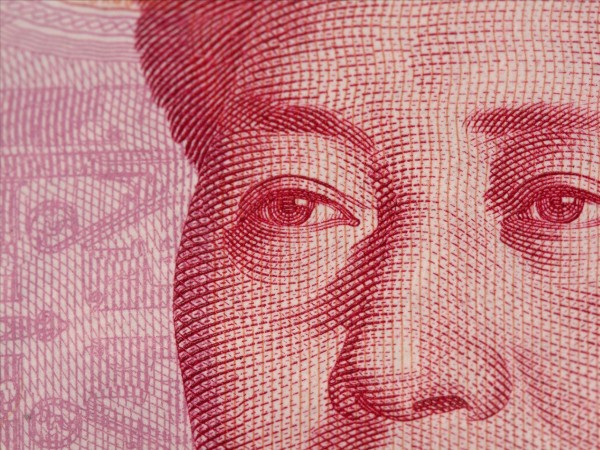 But what will be the effect of the releasing of reserves? Will the boost be confined to $100bn or will there be a money multiplier effect? It is certainly hoped by the authorities that this will stimulate the process of credit creation. But how much credit is created depends not just on banks’ willingness to lend, but also on the demand for credit. And that depends very much on expectations about future rates of economic growth.
But what will be the effect of the releasing of reserves? Will the boost be confined to $100bn or will there be a money multiplier effect? It is certainly hoped by the authorities that this will stimulate the process of credit creation. But how much credit is created depends not just on banks’ willingness to lend, but also on the demand for credit. And that depends very much on expectations about future rates of economic growth.
One issue that concerns both the Chinese and overseas competitors is the effect of the measure on the exchange rate. By increasing the money supply, the measure will put downward pressure on the exchange rate as it will boost the demand for imports.
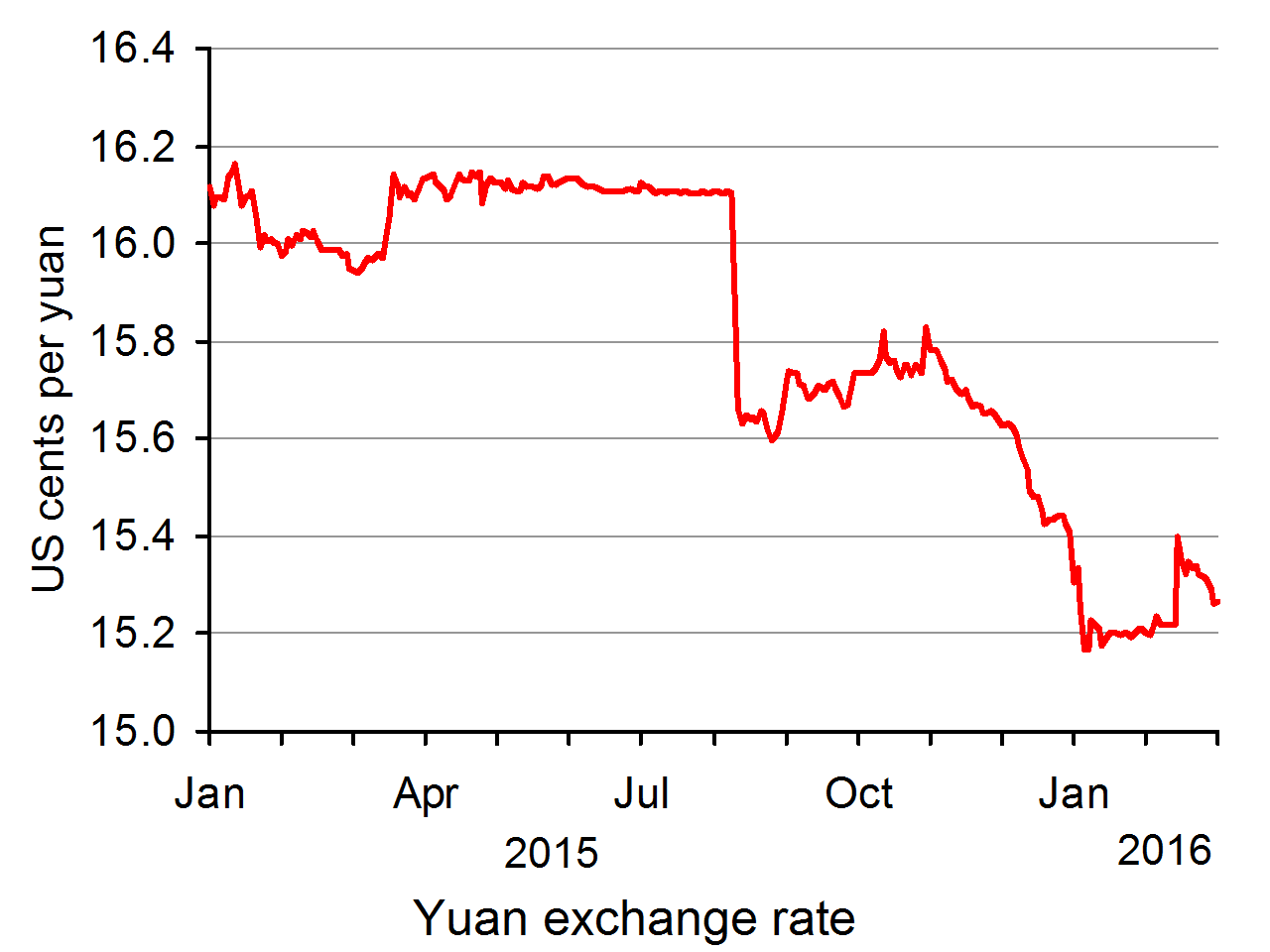 The Chinese authorities have been intervening in the foreign exchange market to arrest a fall in the yuan (¥) because of worries about capital outflows from China. The yuan was devalued by 2.9% in August 2015 from approximately ¥1 = ¢16.11 to approximately ¥1 = ¢15.64 (see chart) and after a modest rally in November 2015 it began falling again, with the Chinese authorities being unwilling to support it at the November rate. By January 2016, it had fallen a further 2.8% to approximately ¢15.20 (click here for a PowerPoint file of the chart).
The Chinese authorities have been intervening in the foreign exchange market to arrest a fall in the yuan (¥) because of worries about capital outflows from China. The yuan was devalued by 2.9% in August 2015 from approximately ¥1 = ¢16.11 to approximately ¥1 = ¢15.64 (see chart) and after a modest rally in November 2015 it began falling again, with the Chinese authorities being unwilling to support it at the November rate. By January 2016, it had fallen a further 2.8% to approximately ¢15.20 (click here for a PowerPoint file of the chart).
But despite the possible downward pressure on the yuan from the cut in the reserve requirement, it will probably put less downward pressure than a cut in interest rates. This is because an interest rate cut has a bigger effect on capital outflows as it directly reduces the return on deposits in China. The central bank had already cut its benchmark 1-year lending rate from 6% to 4.35% between November 2014 and October 2015 and seems reluctant at the current time to cut it further.
China central bank resumes easing cycle to cushion reform pain Reuters, Pete Sweeney (29/2/16)
China cuts reserve requirements for banks to boost economy PressTV (29/2/16)
China Moves to Bolster Lending by Easing Banks’ Reserve Ratio New York Times, Neil Gough (29/2/16)
Economists React: China’s ‘Surprise’ Bank Reserve Cut Wall Street Journal (29/2/16)
 China Cuts Banks’ Reserve Requirement Ratio Bloomberg, Enda Curran (29/2/16)
China Cuts Banks’ Reserve Requirement Ratio Bloomberg, Enda Curran (29/2/16)
 China Reserve-Ratio Cut Signals Growth Is Priority Over Yuan Bloomberg, Andrew Lynch (29/2/16)
China Reserve-Ratio Cut Signals Growth Is Priority Over Yuan Bloomberg, Andrew Lynch (29/2/16)
China reserve ratio cut not a signal of impending large-scale stimulus: Xinhua Reuters, Samuel Shen and John Ruwitch (2/3/16)
China injects cash to boost growth and counter capital outflows Financial Times, Gabriel Wildau (29/2/16)
China’s Economic Policy Akin To Pushing On A String Seeking Alpha, Bruce Wilds (2/3/16)
China cuts banks’ reserve ratio for fifth time in a year: Why and what’s next Channel NewsAsia, Tang See Kit, (1/3/16)
Questions
- Explain what is mean by the required reserve ratio (RRR).
- Explain how credit creation takes place.
- What will determine the amount of credit creation that will take place as a result of the $100bn of reserves in Chinese banks released for lending by the cut in the RRR from 17.5% to 17%.
- What prompted the recent cuts in the RRR?
- Why may China’s recent monetary policy measures be like pushing on a string?
- Is the reduction in the RRR a purely demand-side measure, or will it have supply-side consequences?
- Explain how different types of monetary policy affect the exchange rate.
- Should other countries welcome the cut in China’s RRR? Explain.
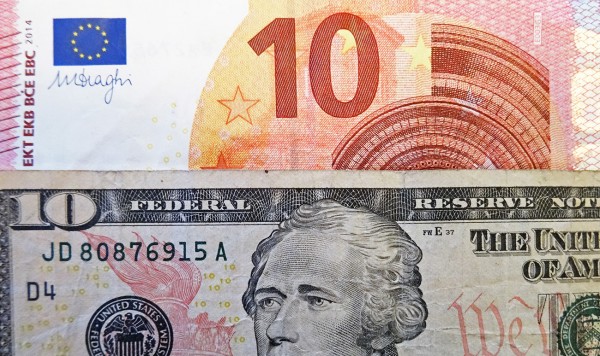 The Federal Reserve chair, Janet Yellen, has been giving strong signals recently that the US central bank will probably raise interest rates at its December 16 meeting or, if not then, early in 2016. ‘Ongoing gains in the labor market’ she said, ‘coupled with my judgement that longer-term inflation expectations remain reasonably well anchored, serve to bolster my confidence in a return of inflation to 2%.’ This, as for many other central banks, is the target rate of inflation.
The Federal Reserve chair, Janet Yellen, has been giving strong signals recently that the US central bank will probably raise interest rates at its December 16 meeting or, if not then, early in 2016. ‘Ongoing gains in the labor market’ she said, ‘coupled with my judgement that longer-term inflation expectations remain reasonably well anchored, serve to bolster my confidence in a return of inflation to 2%.’ This, as for many other central banks, is the target rate of inflation.
In anticipation of a rise in US interest rates, the dollar has been appreciating. Its (nominal) exchange rate index has risen by 24% since April 2014 (see chart below).
In the light of the sluggish eurozone economy, the ECB president, Mario Draghi, has been taking a very different stance. He has indicated that he stands ready to cut interest rates further and increase quantitative easing.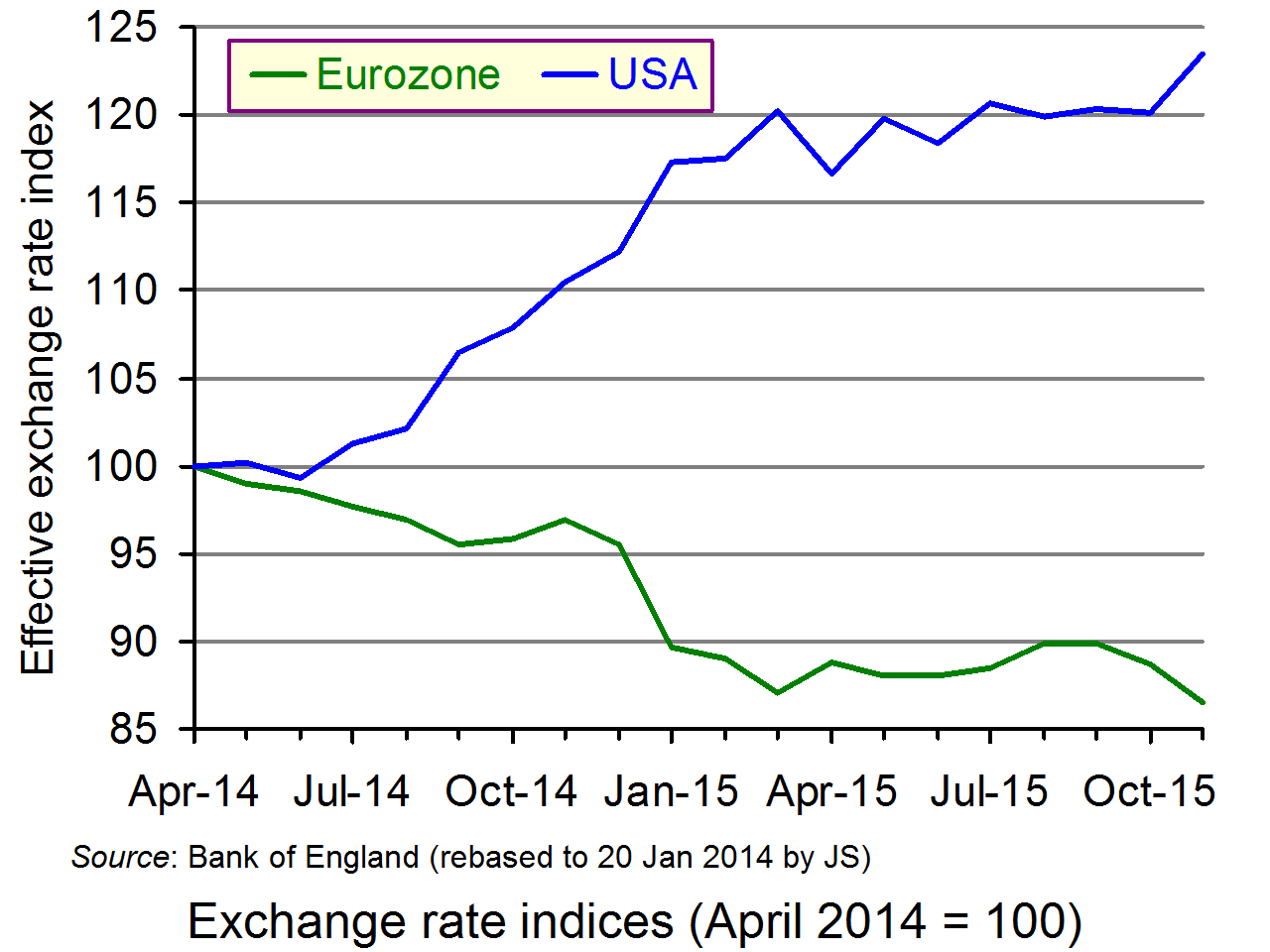 At the meeting on 3 December, the ECB did just that. It announced a further cut in the deposit rate, from –0.2 to –0.3 and an extension of the €60 billion per month QE programme from September 2016 to March 2017 (bringing the total by that time to €1.5 trillion – up from €1.1 trillion by September 2016).
At the meeting on 3 December, the ECB did just that. It announced a further cut in the deposit rate, from –0.2 to –0.3 and an extension of the €60 billion per month QE programme from September 2016 to March 2017 (bringing the total by that time to €1.5 trillion – up from €1.1 trillion by September 2016).
Stock market investors had been expecting more, including an increase in the level of monthly asset purchases above €60 billion. Consequently stock markets fell. Both the German DAX and the French CAC 40 stock market indices fell by 3.6%. The euro also appreciated against the dollar by 2.7% on the day of the announcement. Nevertheless, since April 2014, the euro exchange rate index has fallen by 13%. Against the US dollar, the euro has depreciated by a massive 31%.
So what will be the consequences of the very different monetary policies being pursued by the Fed and the ECB? Are they simply the desirable responses to a lack of convergence of the economic performance of the US and eurozone economies? In other words, will they help to bring greater convergence between the two economies?
Or will the desirable effects of convergence be offset by other undesirable effects for the USA and the eurozone and also for the rest of the world?
|
|
| • |
Will huge amounts of dollar-denominated debt held by many emerging economies make it harder to service these debts with an appreciating dollar? |
| • |
How much will US exporters suffer from the dollar’s rise and what will the US authorities do about it? |
| • |
Will currency volatility lead to currency wars and, if so, what will be their economic effects? |
| • |
Will the time lags involved in the effects of the continuing programme of QE in the eurozone eventually lead to overheating? Already euro money supply is rising, on both narrow and broad measures. |
The following articles address these issues.
Articles
The Fed and the ECB: when monetary policy diverges The Guardian, Mohamed El-Erian (2/12/15)
European stocks slide after ECB dashes hopes of major QE expansion The Guardian, Heather Stewart and Graeme Wearden (3/12/15)
Mario Draghi riles Germany with QE overkill The Telegraph, Ambrose Evans-Pritchard (3/12/15)
How the eurozone missed its shot at a recovery The Telegraph, Peter Spence (3/12/15)
Yellen Signals Economy Nearly Ready for First Interest-Rate Hike Bloomberg, Christopher Condon (3/12/15)
Exchange rate data
Effective exchange rate indices Bank for International Settlements
Exchange rates Bank of England
Questions
- What would be the beneficial effects to the US and eurozone economies of their respective monetary policies?
- Explain the exchange rate movements that have taken place between the euro and the dollar over the past 19 months. How do these relate to the various parts of the balance of payments accounts of the two economies?
- Is it possible for the USA to halt the rise in the dollar while at the same time raising interest rates? Explain.
- Why are some members of the ECB (e.g. the German and Dutch) against expanding QE? Assess their arguments.
- What will be the impact of US and eurozone monetary policies on emerging economies?
- What will be the impact of US and eurozone monetary policies on the UK?
- Why did the euro appreciate after the Mario Draghi’s press statement on 3 December? What has happened to the dollar/euro exchange rate since and why?
 In a recent post, Global Warning, we looked at concerns about the global economy. One of these was about the ineffectiveness of monetary policy to stimulate aggregate demand and to restore growth rates. Despite the use of unconventional monetary policies, such as quantitative easing and negative interest rates, and despite the fact that these policies have become the new convention, they have failed to do enough to bring sustained recovery.
In a recent post, Global Warning, we looked at concerns about the global economy. One of these was about the ineffectiveness of monetary policy to stimulate aggregate demand and to restore growth rates. Despite the use of unconventional monetary policies, such as quantitative easing and negative interest rates, and despite the fact that these policies have become the new convention, they have failed to do enough to bring sustained recovery. In these circumstances, negative interest rates have little effect on stimulating bank lending and, by hurting their balance sheets through lower earnings on the money markets, may even encourage them to lend less
In these circumstances, negative interest rates have little effect on stimulating bank lending and, by hurting their balance sheets through lower earnings on the money markets, may even encourage them to lend lessmoney last week is a straw in the wind.












